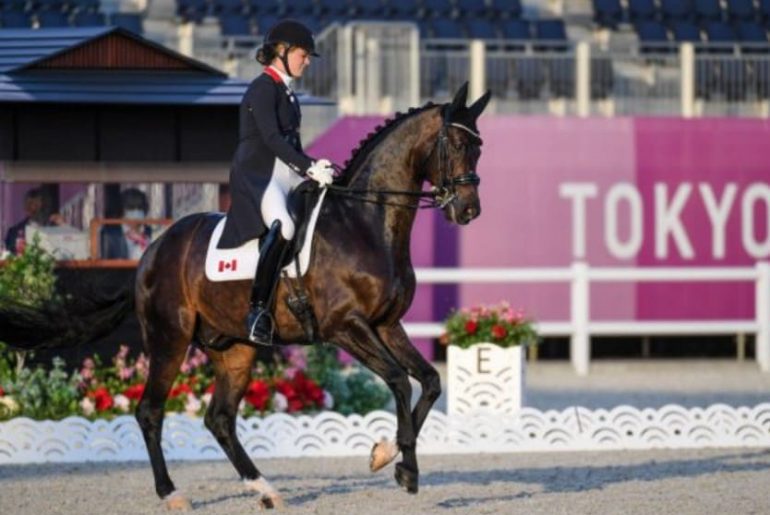Dressage is a specialized equestrian discipline in which minimal commands direct the horse to perform tasks. This sport uses and promotes the natural disposition of the horse through gymnastic exercises. Dressage evaluates different figures and gaits. What is needed is a so-called rideable horse, which reacts to minimal signals or help and carries out a task or lesson exactly.
The dressage training of the horse, the so-called scale of training, is the basis of every equestrian activity, completed in the High School. Here horse and rider seem to merge into one living being. This sport is therefore often compared to dance sport, since equestrian sport becomes an art of riding.
For all other well-known riding styles, such as show jumping, dressage is also the basic requirement.
Development of dressage
One origin of dressage can be found in the courtly horse shows, the so-called “Caroussels” and “Horse Ballets” or quadrilles. Modern dressage has its origins in military riding, as this sport requires a thoroughly trained horse. On the one hand, it has to be muscular in order to be able to carry the rider and his equipment. It must also listen to the rider’s instructions. On this basis, a special riding style and riding lessons developed. Their aim was for the horses to run in beautiful figures and carry the rider accordingly.
Figures in dressage are, for example, the pirouette, piaffe and passage. The gaits are divided into trot, canter and walk. There are both individual and team competitions.
Dressage is also an Olympic discipline in which German athletes are particularly successful and, for example, won Olympic gold in 2008. Germany has been an international leader in this sport for decades, also due to its success in horse breeding. Since 2009, men and women have competed together in German dressage competitions. Women are leaders in dressage worldwide.
Equipment
Dressage saddles and English bridles are used in dressage.
Safety is what counts most for the rider and the following equipment should not be left out during training:
- Properly fitting head protection (riding helmet or riding cap)
- Jacket, sweater or vest
- Safety vest or airbag vest
- Breeches with protectors
- Riding shoes or riding boots
- Special gloves
- protectors for the back
- whip and spurs
The legs and lower body of the horse are usually smeared with petroleum jelly or lubricant. This reduces the risk of injury when touching obstacles. There are also ready-made mixtures available in stores. Horses often also wear gaiters for added protection.
When it comes to the clothing of the riders and the equipment of the horses, it is also important to ensure that there are no unnecessary accessories and decorations. Because these can get caught or chafe.
Equipment in competitions
At dressage competitions or tests in dressage, the equipment of horse and rider must follow a set of rules.
- The dressage saddle allows the rider’s thighs to come into close contact with the horse’s body.
- The bridle is usually a double bridle (transfer of rein aids to the lower jaw and poll) with a bridle (softens the effect of the double bridle).
- Bridle reins and double bridle reins enable the transmission of finely tuned aids from the rider’s hand to the horse’s mouth.
- Protective leggings for the horse are prohibited
- The use of the dressage whip is prohibited
- Spores are allowed, the length of the spore spine may not exceed 3.5 centimeters.
- Spurs without a thorn are also allowed.
The clothing of the riders is strictly prescribed and consists of
- a dark riding jacket or uniform jacket; in performance tests such as the Prix Sankt Georges, a black or
- dark blue tailcoat
- a white breeches
- a white shirt
- plastron or tie
- black riding boots
- white riding gloves
- a headgear: top hat, bowler hat or uniform hat
Training of the horse
Dressage riding does not focus on conditioning the horse to respond to commands in the narrower sense of dressage. It’s more about gymnastics and sensitization of the horse to increase strength, mobility and permeability. Permeability is defined as the horse’s ability and willingness to respond to the rider’s instructions and help.
Training in dressage encourages and refines the horse’s natural movements and enables the animal to optimally carry the weight of the rider. This also helps keep the horse healthy. A dressage horse is trained using a training scale.
Dressage figures
The dressage tasks in a competition consist of a certain number of lessons. The typical figures must be shown in a certain order in corresponding difficulty levels. In a free program with background music, however, the sequence can be chosen freely.
The basic gaits are walk, trot and canter on straight and curved lines, the so-called track figures. The horse moves forwards, sideways or backwards. More complicated movements occur in the higher disciplines of dressage. The assessment assesses the rider’s seat and aids, the movement and rideability of the horse and the correctness of the performance of the required lessons.
Typical figures in dressage are
- Forehand turn, a turn around a point near the inside front foot
- Hindquarter turn, here the horse turns on the inside hind leg
- Short U-turn, the horse turns 180 degrees
- Pirouettes, where the horse is turned around the inside hind leg. Proper pirouettes, however, are high school.
- Leg yields can be described with the movements “reduce square” and “enlarge square” or “reduce circle” and “enlarge circle” and are typical exercises in dressage.
- Travers and renvers, forward and sideways movements of the horse in different evaluation directions
- Traversal, a forward-sideways movement at a trot or canter along a diagonal line
- With travers, renvers and traversals, the hoof line is particularly important. These exercises already require a high level of trust and training from both horse and rider.
High school
High school exercises are difficult to learn and require a lot from rider and horse. A horse only continues to be trained for this level of dressage from the age of five and after basic training. It can take up to five years to master all the figures of the high school. Therefore, horses are only admitted to high school from the age of 12.
The demanding figures in the so-called high school are for example
Piaffe, from the French term “piaffer”, prance, stomp: The horse performs a trot-like movement at the spot
Spanish Step: The arch of the front foot through the air is particularly high and expansive.
Passage is a trot in delayed strides with an extended supporting or hanging leg phase.
Redopp or Terre à terre is a short, high, rocking gallop in two or slightly shifted four beats almost on the spot. Both front hooves are raised and set down again slightly offset in front of each other, then both hind legs jump in the same way.
Volte denotes a small circle
Pessade is a semi-volte where the hind legs are held inside so they describe a smaller circle than the front legs.
Gallop pirouettes can only be performed by horses that have been trained for several years and have enough experience.
Dressage tests
Depending on the level, there are different tests in dressage, for example
- Prix St Georges
- Intermediary I
- Intermediate I Freestyle
- Intermediary II
- Intermediaries A and B
- Dressage Grand Prix
- Grand Prix Special and
- Grand Prix Freestyle.
Valuation
At tournaments, riders and horses receive a score from 0 (not shown) to 10 (excellent) in dressage tasks. There is either a grade for the entire assignment or an overall grade. This consists of separate grades for each individual lesson of the assignment. The tests are carried out individually or in small groups on a standardized dressage arena. The assessments are carried out by up to five judges together or individually.
The Rider Aids
The so-called rider aids are the necessary actions of the rider on the horse. A rider has a number of options for giving the horse minimal signals as to what movements the animal should make. If the horse carries out the requirements accordingly, one speaks of a lesson. Through the dressage these movements of the horse are improved and refined.
- Thigh aids are easiest for the horse to understand: the rider presses the thigh against the horse, instructing it to move forwards, to the side, or to brake.
- Giving in or tightening the reins signals the horse
- to stand still
- to get up
- to turn or
- to go sideways.
- Weight aids are weight shifts by the rider, which show the horse the way. A one-sided load shows the animal, for example, that it should move to the side or turn.
- The lower back aid signals to the horse that it should relax or that a new task is waiting.
- Tuning aids are rarely used in dressage and are used more to calm young or nervous horses.





